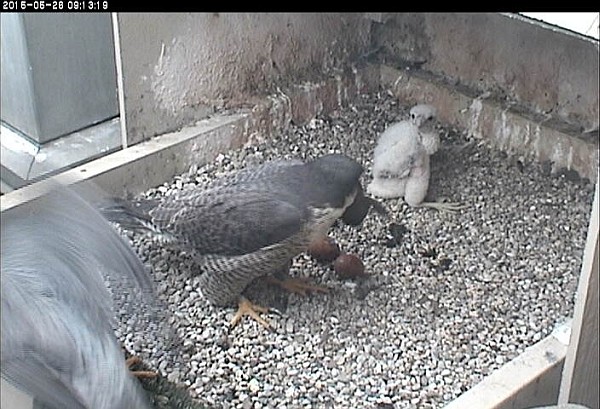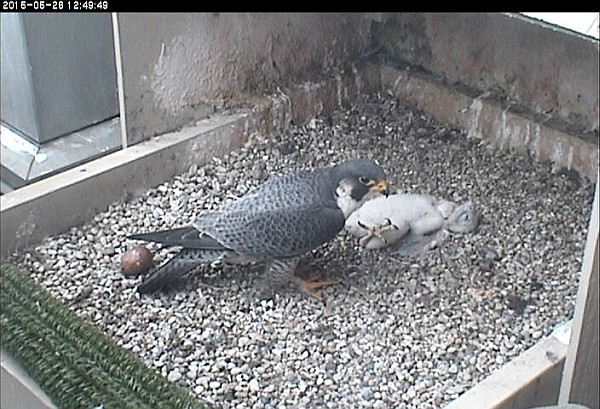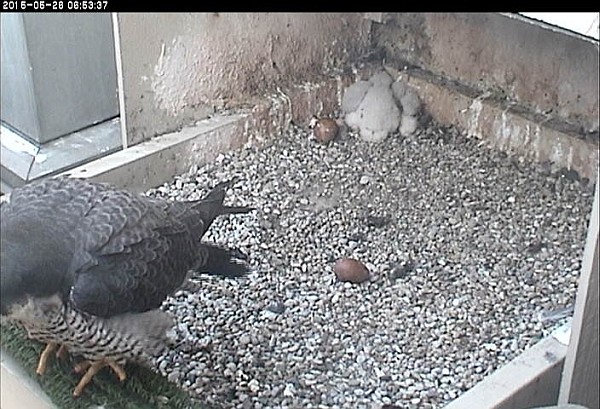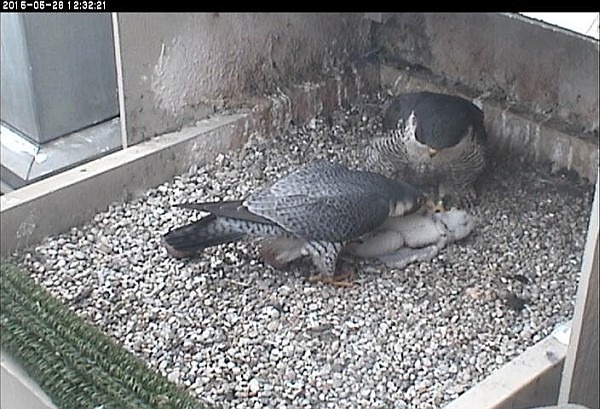
News of peregrine falcon activity at the Cathedral of Learning, 26 May 2015:
The chick was up, the chick was down, the chick came up again. He is an active “Special Needs” nestling.
Don’t worry if you hear him ‘crying.’ All peregrine chicks cry or whine when they are hungry. This is not a sign of distress, it’s a call of hunger. Watch what Dorothy and E2 do when the chick cries. They bring him food. After he eats he stops crying and falls asleep with a full crop as shown below.

Peregrine parents use food as a teaching tool. For instance, they teach their youngsters to hunt by holding food just out of reach in the air so the youngsters will fly up to grab it. You might see Dorothy or E2 holding food just out of reach when the chick is on his back. They are working with him.
We can see on camera that the chick’s legs are wobbly (see end of video). Yesterday he compensated by using the wall for support. Grown up peregrine falcons roost standing up with their faces to the cliff wall. The chick showed good progress by roosting in the position shown below.

Dorothy and E2 conferred on the chick’s condition. They’re adapting to the situation and giving him extra special care, feeding him on his back and even helping him get up. I have never seen peregrines do that! I’m learning something new and gaining even more respect for Dorothy and E2 because we can see them on camera.

Some aspects of the chick’s condition are visible on camera but we cannot diagnose from a distance. The chick will be given a thorough health check on Banding Day this Friday.
NOTE! that the banding event is not open to the public. I will be there and post an update as soon as possible afterward. Stay tuned at this link — Outside My Window — for the latest updates.
(photos from the National Aviary camera at University of Pittsburgh)
Dorothy and E2 are an inspiration. If this chick doesn’t survive, it won’t be for lack of parenting skills. Thank you, Kate, for laying everything out so clearly.
Kate thanks very much for the insight. Am amazed at the “parenting” skills of Dorothy and E2. Very interesting, albeit difficult at times, to watch. Will be interesting to see what information the medical examination reveals.
Thank you, Kate, for the continued updates and your measured and compassionate responses to all who are following this incredible story.
As a mom of a special needs child, it warms my heart to know that humans aren’t the only species who try to do their best for their children. As sad as it is to know that Dorothy’s chick is a “special needs child,” it’s also heartening to know that she and E2 are trying to make their chick’s life comfortable by studying it and adapting to its needs. They are an inspiration to anyone who is a parent of normal or special needs children.
As for the chick, it is good news that it is exhibiting some normal behaviors. I feel there is still hope for this special little bird.
This is the first time I’ve seen E2 anywhere near the chick since I can remember. It’s fascinating and touching that he is also on board with the “special needs” chick rearing program!
Echoing the others in thanking you for providing us with an update. This is certainly an unusual challenge for Dorothy and E2, and they are doing all they can to care for their chick. Truly an amazing PEFA family. Will be anxiously awaiting the results on banding day.
Again, I’m in awe of Dorothy and E2 — and it. Probably a very good thing the banding will not be online….look forward to your posts. Could it be possible that since Dorothy is “grudgingly” aware that humans will be coming to the nest, she’s keeping it going for the check-up? Could she be THAT smart? She sure looks at the cameras a lot.
Gindy, no Dorothy is not keeping it going for the checkup. Humans are the peregrines biggest enemy. She will be angry and will defend it when the banders come to get her chick.
Thank you agin Kate for your knowledge and wisdom. I have learned so much about these marvelous birds and nature from you
Thank you for all of this great information!
Thanks Kate! By reading your blog I understand a lot more about the baby. Can’t wait to read more!! Thanks again!!
Kate, I am curious how the chick will be banded while Dorothy is near.
Karyn, The chick will be taken away from the nest area so Dorothy cannot interfere.
If the chick has some deformity could it be put in the aviary or elsewhere like they do with Eagles that can not be released into the wild?? Or will they put it back with Dorothy and let nature take its course. It is trying soooo hard. Would be a shame to let it die. They do it with other birds why not this baby??
Patti, I do not know the answer to your question and … making your wishes known to me will not make your wishes come true. I am not in charge.
Thanks Kate. Maybe you could pass it on however???!!!
Sorry, Patti, Click here for my earlier comment explaining my policy.
Thanks for all the info Kate, really helps to know what is happening.
Thanks for the updates and all the information. You’ve shown extraordinary patience with those who do not seem to understand the overall purpose for the camera and of the game commission. Kudos to you, Kate.
so relieved to find the baby upright when I clicked on this afternoon! I held my breath as the page was loading. Am so fond of this little guy and his perseverance.
West Chester PA
Again, this is amazing and fascinating. Thanks so much for keeping up the Blog and Facebook updates.
I saw these birds as a warrior specious were the ston survive. The are the klingon s of the bird world and now thanks to these sites I see another fascet of then. There response to this eyes is amazine.
One thing I wanted to convey to you, Kate, is that whatever happens with this chick, even if it’s bad news, you’ve made it easier to accept. Thank you.
Thanks for all the great info from everyone! I have been watching Dorothy and E2 and can not believe the compassion they have and the caring they are giving this chick. He/she is in good hands.
Kate – I too want to thank you for giving me a feeling of relief from reading the information you post about our special needs chick (love that description). It has been difficult to watch, but now I look for any new postings from you to help me understand what is happening. Spunky little guy and great parents.
I was not aware of the banding. How do the parents react when the chicks are returned. Are they present right away. How long will the banding take?
Mari, the parents are fine when the chicks are returned. Takes about half hour. Keep in mind, though, that this chick is getting a medical exam to determine whether he is fit enough to return to the nest, to live in the wild. Don’t know how long that will take.
Kate, would they euthanize the chick or return it to the nest if they feel it’s not viable?
Mari, I don’t know the answer
Glad to see that the chick has been upright all day today. I was reading about baby chickens that initially have a problem with their legs and they seem to be able to recover from it. Perhaps this little chick will be OK after all. In any case, it’s been amazing to watch how wild parents deal with offspring that are not developing in the usual manner. It’s amazing how calm and supportive they’ve been (they know what’s wrong and even manage to try to do things to fix it). It looked today like Dorothy kept urging the chick to get up and move around, presumably to strengthen its legs.
It’s kind of a shame that this kid will be removed from its comfort zone, to risk losing the progress that it has made and may make in the coming days. Removal from the nest and banding has profound effects on the attitude and spirit of these young birds. The last thing this one needs right now is human handling and clumsy bands on its legs, and to be out of reach of its mother, no matter what the situation.
the chick is progressing nicely- he has been very alert, he is eating, and i saw a few PS too! oh, and he has managed to walk a bit all the time staying upright! deciding to euthanize this little one because he may not survive in the wild gives one a lot to think about. deformed he may be, but that doesn’t mean he cannot live out his life in a safe place. in caring hands- he has determination and incredible spirit!
who will be doing the banding? i want them to know that there are people willing to foster this little chick- i would like to contact them directly. thank you!
Thank you Kate for all of the information. Its tough to watch but amazing as well to see how these parents take care of their offspring.
Kate, if it turns out he’s not heathy enough to live in the wild why can’t he live at the aviary?
Deb, if he’s not healthy enough to live in the wild he will go to rehab.